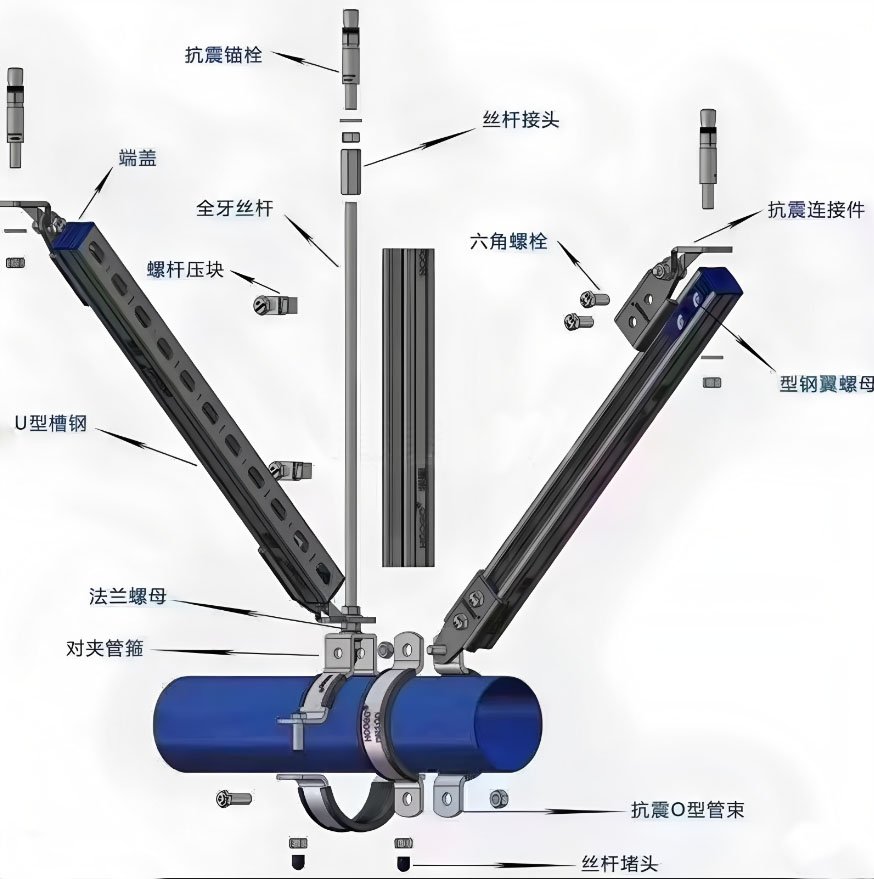Analysis of Seismic Bracket Disassembly
A seismic bracket is a component or device that limits the displacement of ancillary mechanical and electrical engineering facilities, controls facility vibrations, and transfers loads to the supporting structure. Its core function is to provide reliable protection for building mechanical and electrical engineering facilities during earthquakes, withstand seismic forces from any horizontal direction, reduce earthquake hazards, and protect people’s lives and property. (Ref) It consists of anchoring bodies, reinforcement hangers, seismic connection components, and seismic diagonal braces, as specified in GB50981-2014 “Code for Seismic Design of Building Mechanical and Electrical Engineering”. The composition of the building mechanical and electrical seismic system also includes vertical pipe bundles, steel beams and purlin clamps, circular pipe hangers, seismic diagonal brace systems, seismic steel hangers and supports, etc. (Ref)

Key Components and Functions of Seismic Brackets
- Anchoring Body: Connects firmly with the building structure and serves as the foundation for transferring the load of the seismic bracket to the supporting structure, ensuring the overall stability and reliability of the seismic bracket. (Ref)
- Reinforcement Hanger: Primarily responsible for bearing the gravity load of the mechanical and electrical engineering facilities and working in coordination with other components during an earthquake to limit excessive displacement of the facilities. (Ref)
- Seismic Connection Components: Mostly adopt hinge forms, providing a buffer-like function during earthquakes, avoiding potential damage caused by rigid connections. (Ref)
- Seismic Diagonal Brace: With its unique diagonal brace structure, it effectively resists and mitigates the effects of horizontal seismic forces (i.e., transverse waves). According to the principle of force decomposition, the upward diagonal pull can be decomposed into horizontal force Fx (the horizontal seismic load effect value) and vertical force Fy (the gravitational load effect value), allowing the originally unrestricted pipeline support system in the horizontal direction to be safe and reliable during an earthquake, preventing the collapse of the pipeline support system. (Ref)
Differences and Advantages of Seismic Brackets Compared to Traditional Brackets
Differences between Seismic Brackets and Traditional Brackets
| Comparison Item | Seismic Bracket | Traditional Bracket (Non-Finished Bracket) |
|---|---|---|
| Load-bearing Performance | Reliable load-bearing, stable performance, strong resistance to seismic forces, capable of withstanding seismic forces from any horizontal direction. (Ref) | Mainly bear gravity load, weak resistance to horizontal seismic forces. |
| Component Sources | All components should be finished components. Except for C-shaped channel steel and fully threaded hangers, which can be cut on site, no other products should be processed on site. (Ref) | Need to process steel on site: cutting, welding, punching, etc. (Ref) |
| Installation Method | Factory production in batches, direct installation on site without welding or drilling, simple cutting in some cases. (Ref) | Complicated on-site processing, time-consuming and labor-intensive, prone to installation errors. (Ref) |
| Safety Hazards | Third-party verification, node load calculation, low safety hazards. (Ref) | Maximum load unclear, not third-party verified, node load not calculated, causing significant safety hazards. (Ref) |
Advantages of Seismic Brackets
- Enhanced Seismic Safety: During an earthquake, it can effectively protect the mechanical and electrical systems, minimize damage to equipment within buildings, and prevent secondary disasters such as fires caused by falling equipment, thus reducing losses to life and property caused by strong earthquakes. (Ref)
- Ensuring System Functionality: In high-rise buildings encountering earthquakes, not only the external building can resist earthquakes but also the internal building electrical lines from falling dangerously, ensuring that indoor electrical equipment can still supply power during an earthquake and preventing the entire building’s electrical equipment from being paralyzed. (Ref)
- Convenient and Efficient Installation: As a finished bracket, it does not require complex processing on site and can be directly installed, greatly improving installation efficiency and shortening the construction cycle. (Ref)
Installation Prerequisites and Precautions for Seismic Brackets
Installation Prerequisites
The prerequisite for installing seismic brackets is that gravity suspenders must meet the conditions and be able to withstand the gravity load of all pipes and mediums in the vertical direction, i.e., the function requirements can be met without considering the gravity load on the seismic suspenders. (Ref)
Precautions
- Component Usage Requirements: All components of the seismic hanger should be finished components. Direct use of angle iron, long screws, etc., to piece together so-called “seismic hangers” is strictly prohibited. (Ref)
- Insulation Pipe Design: The limit of insulation pipe seismic hangers should be designed according to the size of the pipe after insulation, and should not restrict the displacement of the pipe due to thermal expansion and contraction. (Ref)
- Load Calculation: Seismic brackets should be calculated according to the loads they bear to ensure safe and reliable operation under seismic action. (Ref)
Application Fields and Development Trends of Seismic Brackets
Application Fields
Seismic brackets have been applied in various fields, including building water supply and drainage projects, building electrical projects, building heating and ventilation projects, solar photovoltaic systems, subway bracket systems, etc. After seismic reinforcement, building water supply and drainage, fire protection, heating, ventilation, air conditioning, gas, heating, power, communication, and other mechanical and electrical engineering facilities can withstand earthquakes of the design seismic intensity in the region, reducing earthquake damage and minimizing secondary disasters. (Ref)
Development Trends
- High-tech: Seismic brackets will develop towards high-tech, such as incorporating microchips to enable remote detection of bridges’ foundations, transmitting real-time data for dynamic monitoring, and using big data to create a comprehensive network for future seismic testing. (Ref)
- Systematization: The development of a seismic technology installation engineering system network, which includes production, installation, testing, and acceptance as a packaged systematic project. (Ref)
- Diversification of Connection Modes: Seismic connectors will evolve towards diversified connection modes, adopting spherical universal joint connections and eliminating external screw connections, favoring more flexible and efficient connection methods. (Ref)
- Multi-functionality: Seismic brackets will not only be used for seismic reinforcement but also for controlling horizontal displacement of buildings, fire isolation, noise control, and other multi-functional applications. (Ref)
